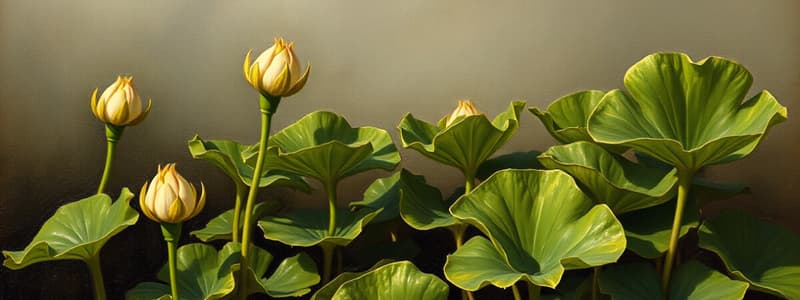Podcast
Questions and Answers
What type of root system is characteristic of dicotyledons?
What type of root system is characteristic of dicotyledons?
- Fibrous roots
- Main tap root with lateral roots (correct)
- Adventitious roots
- Rhizomatic roots
What is one distinguishing feature of monocotyledons in their leaf structure?
What is one distinguishing feature of monocotyledons in their leaf structure?
- Broad leaves with a network of branched veins
- Leaves shaped like needles
- Narrow leaves with parallel veins (correct)
- Leaves with a serrated edge
Which of the following is true regarding the stomata distribution in dicotyledon leaves?
Which of the following is true regarding the stomata distribution in dicotyledon leaves?
- Stomata are predominantly found on the upper surface
- Dicotyledons have no stomata
- Stomata are typically found on the lower surface (correct)
- Stomata are equally distributed on both leaf surfaces
What do fungi primarily produce for reproduction?
What do fungi primarily produce for reproduction?
What is a common characteristic of bacteria in terms of cell structure?
What is a common characteristic of bacteria in terms of cell structure?
Which of the following features is characteristic of monocotyledons?
Which of the following features is characteristic of monocotyledons?
What distinguishes dicotyledons from monocotyledons in terms of leaf structure?
What distinguishes dicotyledons from monocotyledons in terms of leaf structure?
Which statement is true about fungi?
Which statement is true about fungi?
Which of these structures is typically found in bacterial cells?
Which of these structures is typically found in bacterial cells?
What is a notable reproductive feature of fungi?
What is a notable reproductive feature of fungi?
How would the root system of dicotyledons typically be described?
How would the root system of dicotyledons typically be described?
In which way do monocotyledons typically differ from dicotyledons in their floral structure?
In which way do monocotyledons typically differ from dicotyledons in their floral structure?
What do all living organisms in the plant kingdom have in common?
What do all living organisms in the plant kingdom have in common?
Which characteristic is typically associated with fungi?
Which characteristic is typically associated with fungi?
Flashcards are hidden until you start studying
Study Notes
Monocotyledons
- Characterized by narrow, strap-shaped leaves featuring parallel veins.
- Seeds contain a single cotyledon.
- Roots are fibrous in structure.
- Stomata are evenly distributed on both upper and lower surfaces of leaves.
- Floral parts typically have three petals or multiples thereof.
Dicotyledons
- Feature broad leaves with a network of branched veins.
- Seeds consist of two cotyledons.
- Roots consist of a main tap root with lateral branches.
- Stomata are predominantly located on the lower surface of leaves.
- Floral parts generally include four or five petals or multiples of these numbers.
Plant Kingdom Features
- Organisms possess chlorophyll and engage in photosynthesis for food production.
- Capable of producing flowers as part of their reproductive process.
- Generate fruits that enclose seeds for propagation.
- Seeds germinate under suitable conditions to give rise to new plants.
- Composed of eukaryotic cells, characterized by complex cellular structures.
- Have cell walls primarily made of cellulose, providing structural support.
- Examples include ferns and flowering plants.
Bacteria Features
- Exist in unicellular form, making them the simplest life forms.
- Prokaryotic cells with a cell wall composed of murein.
- Lack a nucleus; DNA resides freely in the cell.
- Some types possess bacterial chlorophyll and are capable of photosynthesis.
- Reproduce asexually through simple binary fission, a rapid process leading to population growth.
Fungi Features
- Composed of eukaryotic cells, fundamentally different from bacteria.
- Have cell walls made from chitin, and some have a combination of chitin and cellulose.
- Majority are multicellular; however, unicellular forms (like yeast) do exist.
- Non-motile, lacking cilia or flagella for movement.
- Typically consist of structures called hyphae.
- The entire structure of a fungus is known as mycelium.
- Reproduction occurs via spores, while yeast specifically reproduces through a process known as budding.
Monocotyledons
- Characterized by narrow, strap-shaped leaves featuring parallel veins.
- Seeds contain a single cotyledon.
- Roots are fibrous in structure.
- Stomata are evenly distributed on both upper and lower surfaces of leaves.
- Floral parts typically have three petals or multiples thereof.
Dicotyledons
- Feature broad leaves with a network of branched veins.
- Seeds consist of two cotyledons.
- Roots consist of a main tap root with lateral branches.
- Stomata are predominantly located on the lower surface of leaves.
- Floral parts generally include four or five petals or multiples of these numbers.
Plant Kingdom Features
- Organisms possess chlorophyll and engage in photosynthesis for food production.
- Capable of producing flowers as part of their reproductive process.
- Generate fruits that enclose seeds for propagation.
- Seeds germinate under suitable conditions to give rise to new plants.
- Composed of eukaryotic cells, characterized by complex cellular structures.
- Have cell walls primarily made of cellulose, providing structural support.
- Examples include ferns and flowering plants.
Bacteria Features
- Exist in unicellular form, making them the simplest life forms.
- Prokaryotic cells with a cell wall composed of murein.
- Lack a nucleus; DNA resides freely in the cell.
- Some types possess bacterial chlorophyll and are capable of photosynthesis.
- Reproduce asexually through simple binary fission, a rapid process leading to population growth.
Fungi Features
- Composed of eukaryotic cells, fundamentally different from bacteria.
- Have cell walls made from chitin, and some have a combination of chitin and cellulose.
- Majority are multicellular; however, unicellular forms (like yeast) do exist.
- Non-motile, lacking cilia or flagella for movement.
- Typically consist of structures called hyphae.
- The entire structure of a fungus is known as mycelium.
- Reproduction occurs via spores, while yeast specifically reproduces through a process known as budding.
Studying That Suits You
Use AI to generate personalized quizzes and flashcards to suit your learning preferences.



